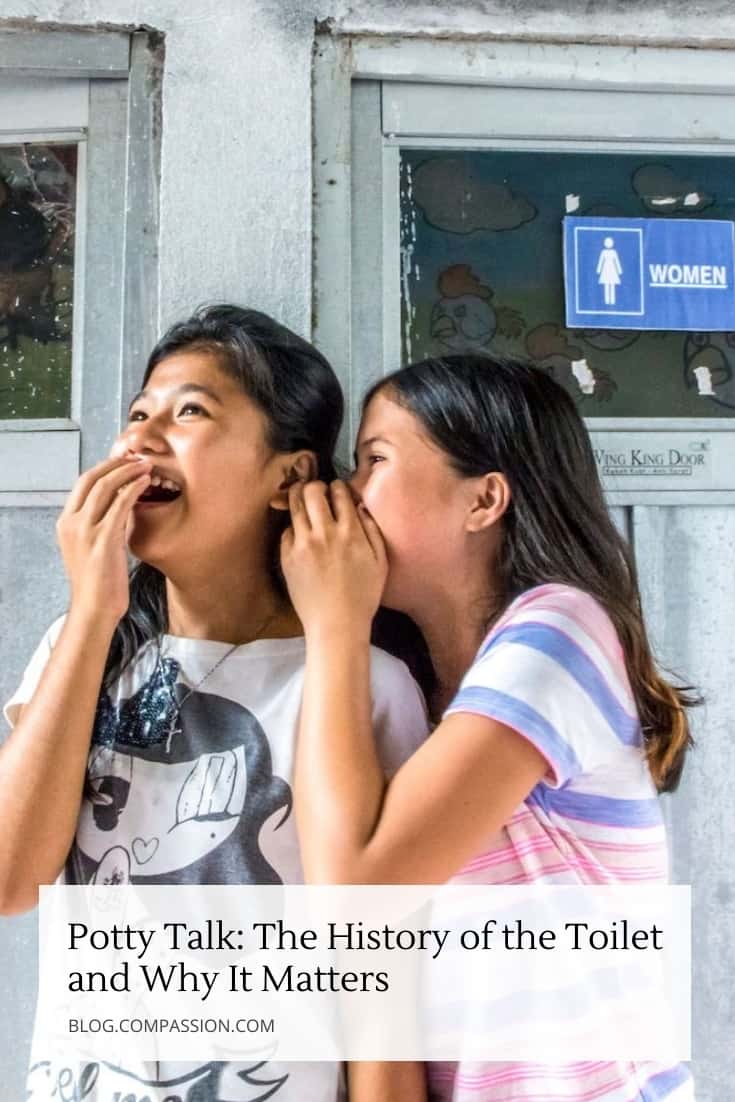
Today is a good day for some potty talk. And no, I’m not talking about the kind we scold kids for! I think we should talk about actual toilets today, specifically the history of the toilet. Do you know why? Because World Toilet Day is coming up — a day set apart to bring attention to the global sanitation crisis. The United Nations made Nov. 19 World Toilet Day to “help break taboos around toilets and make sanitation for all a global development priority.”
So, I say we get down to business and talk toilets.
From Hole in the Ground to Automatic Flush
It’s nearly impossible to trace back to exactly when the first flush toilet was invented, but some historians say it was either invented by the Scots (around 3000 B.C.) or the Greeks (around 1700 B.C.).
Over the next several millennia, the toilet took many different forms — from holes in the ground to glorified port-a-potties. Early Romans had 144 public toilets that were essentially communal outhouses. In Medieval times, English people used “potties,” which were windows they’d toss their waste out of and onto the street. More affluent people used a “garderobe,” or a room that had a long hole suspended over a moat.
The problem with these “potties” and “garderobes” was that they caused sanitation issues. Not only did cities smell bad, but people were getting sick. So, over time, more advanced plumbing systems developed.
However, as populations grew, the construction of latrines and plumbing couldn’t keep up. In overcrowded cities, it wasn’t uncommon for 100 people to share one toilet, causing waste and sewage to spill into the streets. And with that, disease continued to spread.
In 1861, Thomas Crapper was hired by Prince Edward to construct bathrooms in palaces. He didn’t invent the modern flush toilet, but he did have his hand in many toilet-related inventions. In fact, the first flush toilet as we would recognize it today was invented all the way back in the 1500s by Sir John Harrington, a godson of Queen Elizabeth I.
But it wasn’t until the 20th century that modern porcelain “flush toilets” began being widely produced, along with the availability of running water in modern sewer systems. Crazy how long it took, huh? Well, here’s what’s even crazier — there’s only a relatively small portion of the population that has actually benefited from the history of the toilet that I just shared with you.
Why the History of the Toilet Matters

Karen, a girl in the Philippines, shows where her family used to go to the bathroom.
The history of flush toilets matters because for most people in the world, it doesn’t apply. According to the United Nations, 4.5 billion people worldwide live without a safe toilet. That’s three of every five people — 60% of the world population.
The first toilets were holes in the ground. But history stopped there for billions of people living in poverty. And for some, it’s less than even a hole in the ground. Approximately 892 million people still practice open defecation.
And that’s why our world is facing a sanitation crisis. According to the U.N., exposure to human feces is a threat to “public health, living and working conditions, nutrition, education and economic productivity across the world.” The lack of toilets isn’t just causing the global sanitation crisis — it’s fueling the global poverty crisis.
The Surprising Consequences of Not Having a Toilet
For people living in poverty, not having a toilet affects more than just sanitation — especially for girls. Here’s how …
Safety. For the billions of girls in poverty living without a toilet, safety is a major concern. Take 11-year-old Karen for example. Karen’s parents work on a sugarcane plantation in the Philippines. They did not have a toilet in their home, so they would have to run behind the tall sugarcane plants just to relieve themselves.
“It was really demeaning, very uncomfortable and quite scary,” says Romelyn, another girl in Karen’s community. “At nights when I needed to go, I had to wake my mother or my sisters up to go with me into the field just to relieve myself. I wouldn’t dare go there alone.”

Karen no longer has to use the fields as her bathroom. This is her family’s new toilet!
Thankfully, Karen’s and Romelyn’s families were able to get toilets in their homes with the support of Compassion. But over 1 billion women around the world still fear for their safety when going to the bathroom.
Education. According to the U.N., “one-fifth of schools worldwide do not provide any toilet facilities — a particular problem for girls during menstruation.” This is known as period poverty.
It’s not uncommon for girls living in poverty to miss school while on their period. When a girl doesn’t have access to proper feminine hygiene care products and her school doesn’t have a toilet, it makes it nearly impossible to attend class while menstruating. And when she misses school, her education suffers, and escaping poverty becomes even harder.
The seemingly simple addition of a toilet at school could change the future for girls living in poverty. To learn more about period poverty, check out this blog post.
Here’s What We Can Do About It

Potty talk is important — and so is the history of the toilet for all people. So, let’s continue to educate ourselves about the global sanitation crisis and the realities of life without a toilet. Let’s advocate for and act on behalf of people who have been left out of the history of the toilet. And let’s start today.
Would you consider donating to provide bathrooms and hygiene training to children living in poverty?
On this World Toilet Day, you can make a difference. Please join us in praying for all the children across the globe who are living without access proper sanitation, and for the girls whose safety and education are at risk because they don’t have a toilet. If you’re interested in learning about more ways to pray for children in poverty, join the Prayer Network today!
Photos by Vera Aurima and Edwin Estioko. Reporting from the Philippines by Edwin Estioko.






0 Comments |Add a comment